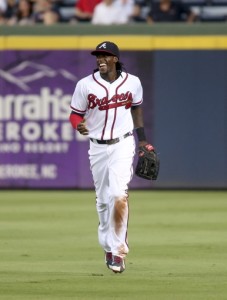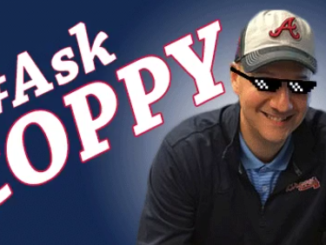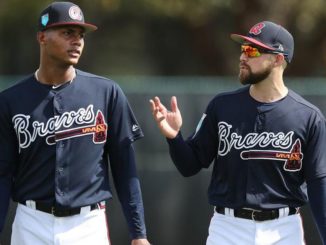
Welcome to another installment of Answers On The Fly. Answers On The Fly runs on Mondays, and is your chance to get your Atlanta Braves questions answered by people you’ve never met and likely have never heard of. Feel free to add your questions to the mailbag.
Questions can be submitted the following ways:
- Email us
- Tweet us (@OFRSports)
- Post them in the Outfield Fly Rule Facebook group.
[sc:InContentResponsive ]
The recent trade of Cameron Maybin to the Detroit Tigers prompted our first question, which was posted in the Outfield Fly Rule Facebook group.
Why did we get so little for Cameron Maybin?
– Walter K.
Chris: Well, the short answer is that we waited too long to trade him. Had we traded him at the deadline in July we probably would have received a little more for him, since he was riding a very successful couple of months.
As Brent Blackwell noted Friday, Atlanta Braves fans may have been slightly overvaluing Maybin’s contributions. He was a relative bright spot in the Atlanta lineup, but he was largely just an average centerfielder when compared to others in baseball. It didn’t help that Maybin was pretty bad in the second half:
| Split | PA | AB | R | H | 2B | 3B | HR | RBI | SB | CS | BB | SO | ||||
|---|---|---|---|---|---|---|---|---|---|---|---|---|---|---|---|---|
| 1st Half | 313 | 280 | 38 | 81 | 10 | 1 | 8 | 44 | 15 | 4 | 29 | 57 | .289 | .356 | .418 | .774 |
| 2nd Half | 242 | 225 | 27 | 54 | 8 | 1 | 2 | 15 | 8 | 2 | 16 | 45 | .240 | .289 | .311 | .600 |
His first half was very serviceable, and reflected a potential turnaround in his career. But his second half performance rightly raises questions among potential trade partners. Was it just a slump? Or was the first half the aberration? After all, his second half slash line seemed far more like his last five seasons (.244/.306/.359).
On July 8th, Maybin was hitting .295/.362/.429. There appeared to be at least some interest in Maybin at the time, as this article and this article seem to indicate. We probably would have received a slightly better MLB-ready arm had we moved him when he was hitting near .300.
[sc:InContentResponsive ]
How much cash has the team generated because it seems like we are getting prospects along with cash. What are we going to use the cash for besides for arbitration?
– Marshell T.
Chris: Over the last year or so, the Atlanta Braves have traded a whole slew of players. I’m not sure if you’ve heard that anywhere else, but trust me…it’s true. This is the kind of groundbreaking insight your subscription fee gets you.

Some of those trades have involved money either going to or coming in from teams. Often, that money is simply used to help cover the salary of the newly acquired player(s). When we traded Chris Johnson to the Indians, he was still owed about $20M over 2 1/2 seasons (and potentially about $29M over 3 1/2 seasons, if Cleveland exercised the 2018 team option). Michael Bourn and Nick Swisher, who came over in the deal, were owed a combined total of about $43.75M over the next 1 1/2 seasons. In order to balance out the deal, the Indians sent about $15M to the Braves, bringing Atlanta’s total outlay down to about $28.75M, or roughly what they would have paid Chris Johnson had they kept him (and exercised the option).
Since the cash that was sent is essentially being used t pay Nick Swisher’s salary this season, there is no ‘gain’ that the team can turn around and use elsewhere. Sure, had Cleveland not sent the cash, we would be paying $15M more than we are now. But had Cleveland not sent the cash as part of the deal, it’s unlikely we would have taken Swisher.
As it sits now, we have essentially received $15M in cash from the Indians, and we also received about $2.5M from the Angels in the Andrelton Simmons trade ( sniff, sniff :'( ). Simmons is due to make $6M this season, and Erick Aybar is due $8.5M. The money from the Angels is being used to pay the difference between the two salaries. So, again, there is no effective ‘gain’ for the team to use elsewhere. The Braves also sent the Tigers about $2M in the Maybin deal, so they are actually probably down a little for 2016, but they have also removed long term salary debt from their books. Still, the money coming in these deals is basically being used to pay the higher paid players coming over in these transactions.
[sc:InContentResponsive ]
Hey…can you guys explain the rules of the Rule 5 draft and give us an idea about which players are at risk? Thanks in advance.
– Luis R.
Chris: Sure. Basically, the Rule 5 draft was designed to keep teams from hoarding young talent in the minors. Any player who meets the following criteria is eligible to be drafted:
- Not currently on the 40-man roster, AND
- Player was drafted at age 18 (or younger) and the upcoming Rule 5 draft will be his 5th, OR
- Player was drafted at age 19 (or older) and the upcoming Rule 5 draft will be his 4th.
Essentially, this means any 18-year olds drafted in the 2011 draft or any 19 year-olds drafted in the 2012 draft.
Teams can choose to protect eligible players by placing them on the 40-man roster. While this protects the player from being drafted, it also starts the clock for determining the player’s option years. It also gets the player a Spring Training invite. Teams usually only add players to the 40-man roster whom they think will be in their plans in the near future, so it also gives you an idea on how a team values certain prospects.
During the draft, teams are free to select any eligible player not protected. Teams pay $50,000 to select a player in the Rule 5 Draft. But if they draft a player, he must go on the 25-man roster for the entire season following the draft. If that player doesn’t stay on the 25-man roster for the full season (90 days of it must be active, so no stashing on the disabled list for the season), he must be offered back to his former team for $25,000. If the original team declines, the player can then be waived.
If a Rule 5 draftee is traded, the team receiving the player must follow the same rules about rostering the player. This applies to the Braves, who acquired Andrew McKirihan from the Marlins, who was himself a Rule 5 draftee.
If a drafted player has a legitimate injury that prevents him from meeting the 90-day requirement, then any balance remaining of the 90-day requirement must be met at the beginning of the next season (the player’s 2nd season with the drafting team). This is the scenario we have with Daniel Winkler. We drafted him from Colorado in last year’s Rule 5 draft. Since he was disabled all year, and not able to fulfill his 90-day requirement, he must do so this year, or we have to send him back to Colorado.
The Braves have chosen to protect Mallex Smith and John Gant. Johan Camargo is eligible for the draft, but he will be left exposed. He is unlikely to be taken, as he is an undersized utility infielder with no power and little speed. He has a career .685 OPS in the low minors.
Johan Camargo wasn't added. But it's hard to imagine a club would take a 21-year-old MI w/ a .695 OPS and no experience above A-Advanced.
— Mark Bowman (@mlbbowman) November 19, 2015
The fact he was the Braves’ #8 prospect (via Baseball America) entering the 2015 season might give you an idea as to the status of our farm system at the time and why some of the trades for prospects have been made.
Thomas Poe (Guest Contributor): Read my blog.




Leave a Reply